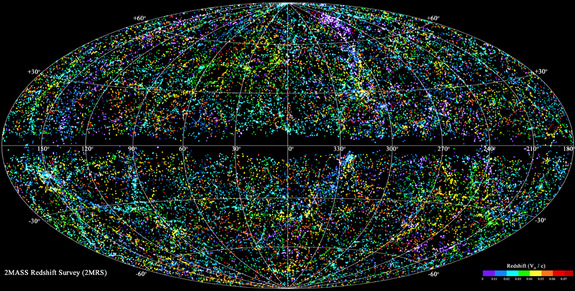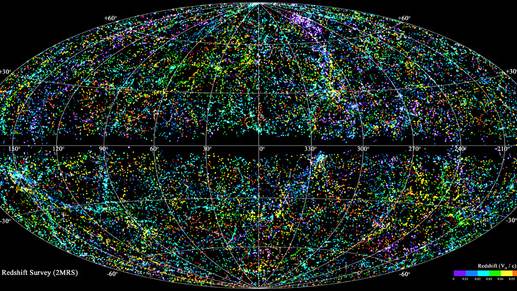New 3-D Map of Universe Is "Best One Yet"
Source: space.com
Astronomers have created the most complete 3-D map of our local universe, revealing new details about our place in the cosmos.The map shows all visible structures out to about 380 million light-years, which includes about 45,000 of our neighboring galaxies (the diameter of the Milky Way is about 100,000 light-years across).

The 2MASS Redshift Survey (2MRS) has catalogued more than 43,000 galaxies within 380 million light-years from Earth (z<0.09). In this projection, the plane of the Milky Way runs horizontally across the center of the image. 2MRS is notable for extending closer to the Galactic plane than previous surveys — a region that’s generally obscured by dust. CREDIT: T.H. Jarrett (IPAC/SSC)
"I think it speaks to our desire to understand our place in the universe," said Karen Masters of the University of Portsmouth in England, during a press conference today. "I wouldn’t be happy if we didn’t have a complete map of the Earth. It’s nice to have a complete map of where we live."
The map was assembled using data from the Two-Micron All-Sky Survey (2MASS) Redshift Survey (2MRS), which took 10 years to scan the complete night sky in near-infrared light. The survey used two ground-based telescopes, the Fred Lawrence Whipple Observatory on Mt. Hopkins, Ariz., and the Cerro Tololo Inter-American Observatory in Chile.
Near-infrared light, which is of a longer wavelength than visible light, can penetrate the opaque clouds of dust common in galaxies. This allowed the 2MRS survey to extend its "eyes" closer to the plane of the Milky Way galaxy than has been possible in previous studies, because that area is heavily obscured by dust.
"This covers 95 percent of the sky," Masters said. "In the infrared, we’re less affected by the gunk in the milky way so we’re able to see down closer to the plane of the galaxy."
Masters presented the new map here today at the 218th meeting of the American Astronomical Society.
The 3-D aspect of the map comes from the fact that researchers measured the cosmic objects’ redshift, which denotes how much its light has been shifted toward the red end of the color spectrum. This happens because of the so-called Doppler effect, which causes the wavelength of light to be stretched when the light’s source is moving away from us.
Because the universe is expanding, measuring an object’s redshift, and hence its velocity, allows astronomers to deduce its distance, because objects that are farther away are moving more quickly.
In addition to providing a more complete picture of our place in the universe, the new map could help solve the perplexing mystery of why the Milky Way moves the way it does with respect to the rest of the universe. This motion, about 370 miles per second (600 km per second) has yet to be explained by the gravitational attraction of the known objects near our galaxy.
Read the full article at: space.com
Video from: YouTube.com
"2MASS (Two Micron All Sky Survey) is a collaboration between the Univ of Mass and the Infrared Processing and Analysis Centre (JPL/Caltech) collecting data from up to 1,400 million light years away. In this short video, colour represents distance. The first objects shown in violet are the closest to us at z less than 0.01, up to 140 million Lys away (z is the fractional shift in the spectral wavelength) and red are the furthest away with z less than 0.09, up to 1200 million Lys away." (2007)






















